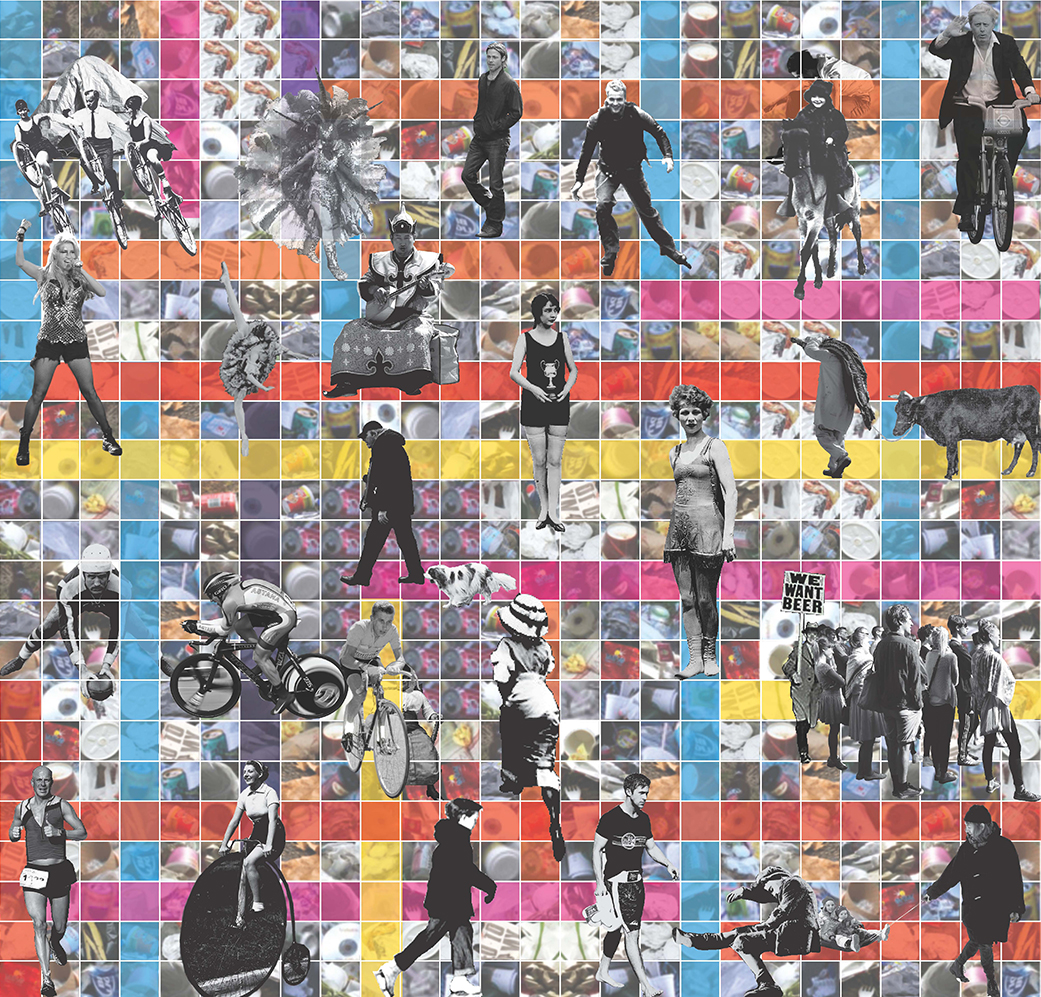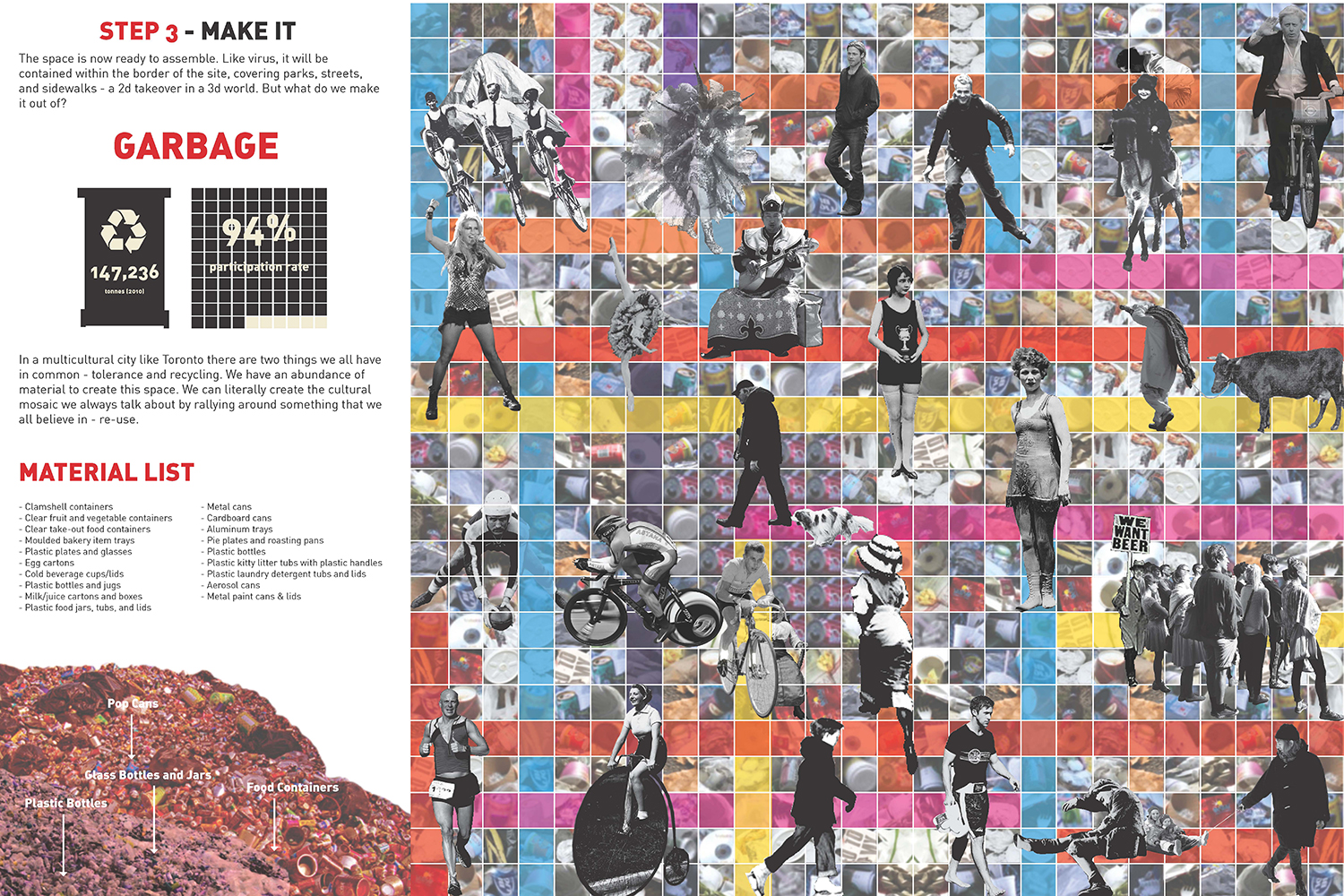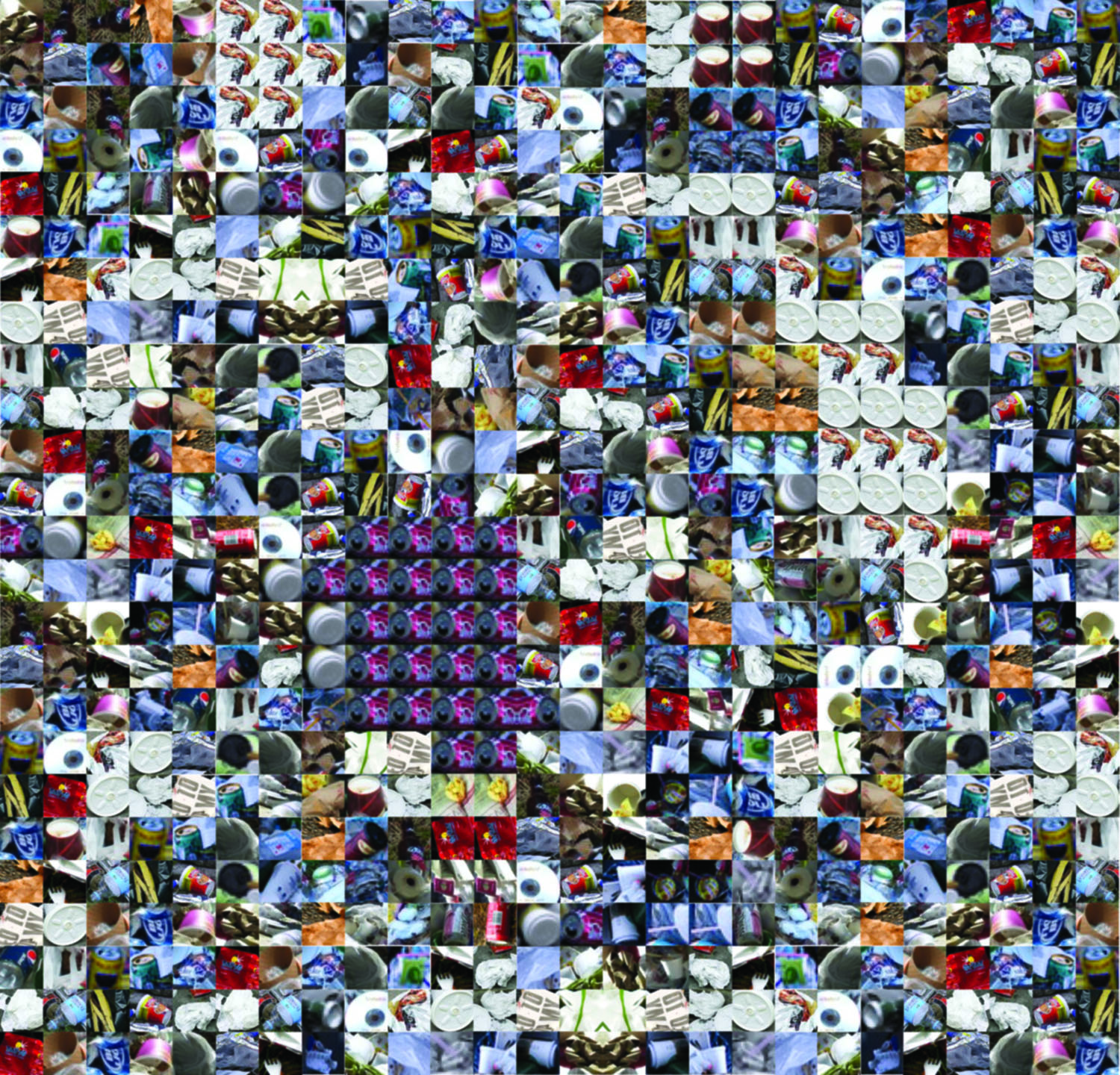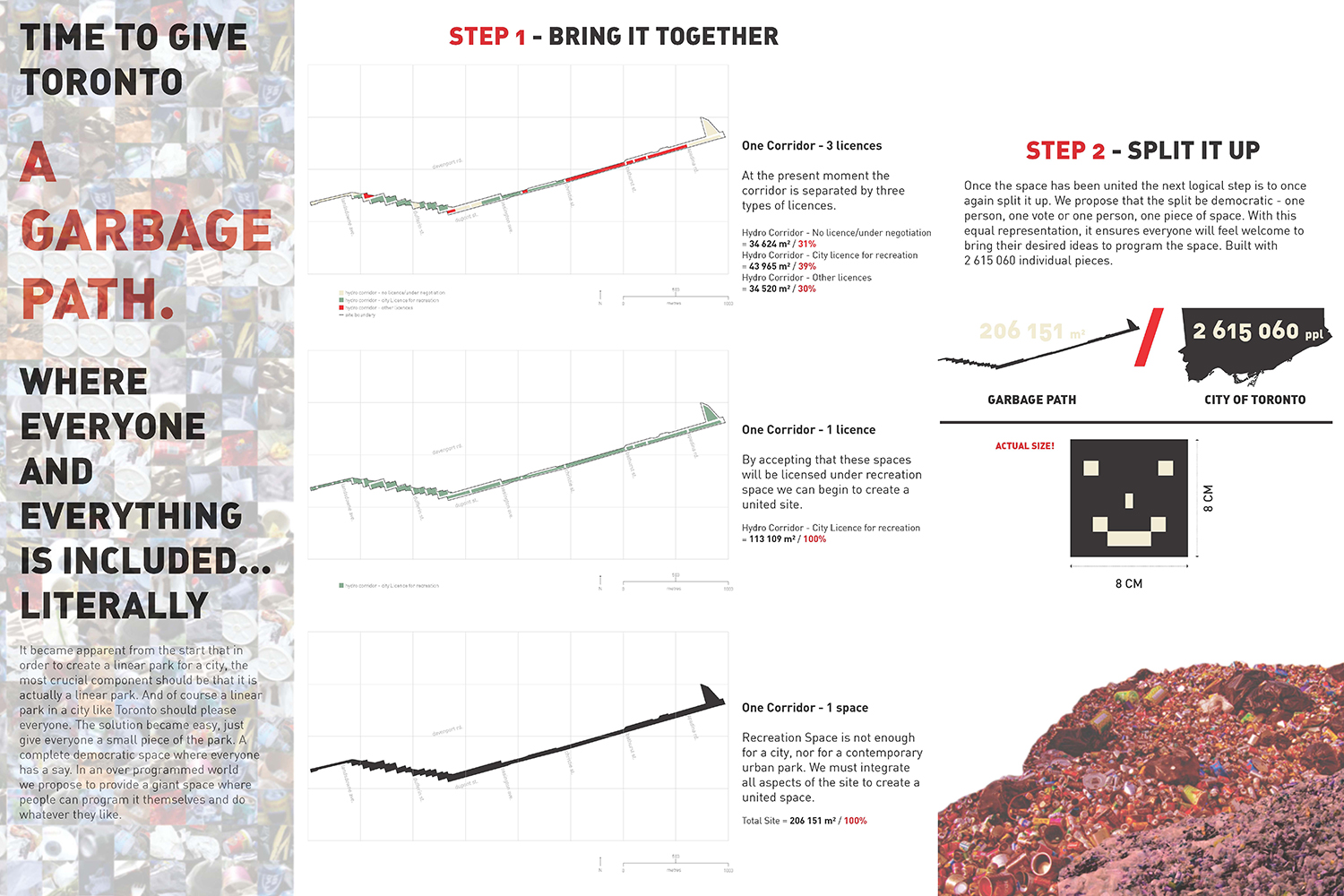A Garbage Path




💭 Project Description
Time to give Toronto— A Garbage Path.
Where everyone and everything is included… Literally.
It became apparent from the start that in order to create a linear park for a city, the most crucial component should be that it is actually a linear park. And of course a linear park in a city like Toronto should please everyone. The solution became easy, just give everyone a small piece of the park. A complete democratic space where everyone has a say. In an over programmed world we propose to provide a giant space where people can program it themselves and do whatever they like.
Once the space has been united the next logical step is to once again split it up. We propose that the split be democratic – one person, one vote or one person, one piece of space. With this equal representation, it ensures everyone will feel welcome to bring their desired ideas to program the space. Built with 2 615 060 individual pieces.
The space is now ready to assemble. Like virus, it will be contained within the border of the site, covering parks, streets, and sidewalks – a 2d takeover in a 3d world. But what do we make it out of?
In a multicultural city like Toronto there are two things we all have in common – tolerance and recycling. We have an abundance of material to create this space. We can literally create the cultural mosaic we always talk about by rallying around something that we all believe in – re-use.
The project team included: Aliya Tejnai, Christopher Pandolfi, and Dylan Cassidy.
To commemorate DoUC’s 10 year anniversary, we have organized an interview series highlighting past DoUC projects.
We wanted to take this milestone opportunity to revisit projects in a fun and reflective way, calling on the perspectives of both past and present DoUC team members. Shifting from objective and brief project descriptions, we revisited our work with a renewed intimacy. With more personality. We hope this series provides deeper insight and understanding to past projects. Or, is simply a fun read!
To help you navigate this series, we recommend first reading the project summary for context. Then, you can explore the interview dialogue. Enjoy! 🙃
ℹ️ A Garbage Path interview was conducted with Chris Pandolfi (CP).
This is a very unique idea, how did you come upon this solution?
CP ⤳ Very honestly, we had been thinking about doing the competition for a number of weeks and we had kept putting it off. We were not really sure if we were going to do it. On the Weekend before it was due (it was due on Monday) I had taken a trip to part of the site and had looked at how much potential it had for programming, but with our research we had completed on parkettes we understood that we had no business planning any type of programming and that the programming to be done throughout the Greenway should be done by the different communities it would engage. They should have the ultimate decision of the future of how the space responded to their needs.
The Greenway or the proposal for the greenway was essentially a tapestry of public land that included hydro corridors and a series of small parks. We thought it would be interesting to propose something that would bring the site together and create it as a singular piece to that would allow for the programming to be created at a more micro scale. From there it was about thinking about way we could create a single element ( a kind of pixel) and grow to create a larger image. The idea for using recycled material cam from a small but of research which showed that at the time 94% of people in Toronto recycled. It was amazing think that 94% of people could agree on and mobilize around one specific idea, especially after the election of Rob Ford had further divided the city. We took this simple idea and divided the site into an equal amount of pixels- each pixel representing a person in the city of Toronto. Each pixel to be a tile on the path made of recycled material generated by the residents.
What is the significance in using garbage for the path?
CP ⤳ See the answer above in relating to the 94%. In addition to recycling being a kind of representational communal act. It was important to think about how the design could experiment with new types of outdoor paving that could maybe find other uses in different contexts, as well as exploring the possibility of aesthetics in recycled material.
On the final design there are sections that are coloured differently— do these represent or map anything? Why did you choose to integrate them in this way?
CP ⤳ The colours were meant to help people imagine the different ways the path could be distributed, what activities or programs would take up space and simply that the pathway once united by a single form would then be able to be subdivided by the communities interests and needs.

How was it received by the The Greenline Competition judges?
CP ⤳ In talking to some of the Judges it was received quite well. Our proposal was very different then many of the other finalists and I feel it was selected to be a finalist due to the fact that it tried to show a different way of thinking about designing a park. Where programming was left to the community and the designers role was simply to help organize and consolidate the pathway in an interesting way.
“Is there manufacturing or ways of making from other cultures that we could take into consideration and learn from. There is lots of room for us to learn to about these processes, rather just a classic manufactured approach.“
Small weird side note, but, if we could do this for an art installation in one area, can we not simply repurpose and use our garbage to build basic structures/paths like this pretty much everywhere? What do you think of that? Would you want to do that?
CP ⤳ LOL! I think if we were to do that I would take a step back and ask why exactly would we do this. For this project the material had a very specific purpose, in the future if we were to do something I would really want to explore how even the making of the materials for the path itself could be more of a communal act? How would these pixels be made? Is there manufacturing or ways of making from other cultures that we could take into consideration and learn from. There is lots of room for us to learn to about these processes, rather just a classic manufactured approach.
How do you think people would receive that?
CP ⤳ I think it’s less about people receiving it and more about how we get people involved. I think our projects always aim to be a here-it-is approach and more of you-already-know-what-it-is because you helped to build it.
“This is a great disconnect between the aspirations of a population and the limitations of a system to deliver on those aspirations.“
Did this project inspire any personal reflection on your own waste habits? How did they compare to the city of Toronto as you previously investigated?
CP ⤳ Not really. I had been to recycling plant when I was in grade 4 and the people that worked at the plant had told us that most things did not get recycled. I think this just made me aware of the act of wanting to recycle and the capabilities of what can actually be recycled. I think lots of people just throw things into the recycling bin because it seems like they should be recycled. This is a great disconnect between the aspirations of a population and the limitations of a system to deliver on those aspirations.

Why do you think we separate ourselves from our waste so significantly? Really, it’s a by-product of our own lifestyle, and communities in other places and countries are left to deal with it. Why don’t we just re-integrate our waste back into our lives more strategically like this?
CP ⤳ Privilege to make waste. Privilege to remove it. Creating waste in itself or the types of waste we get to create is really a huge marker of global inequity. One of the behaviours of capitalism is this idea of deserving something, you deserve it because….(insert what ever bullshit individualism tagline you want). The amount of waste that is produced from the deserving economy is the ones we usually try to hide the most and make disappear. This behaviour of deserving something results in a lack of accountability. In that you already did the work to get it, so whatever problems emerge from it are not your problems. And this behaviour or this type of specific economy is not for everyone on the planet, but the consequences are played out on a planetary scale.
“It’s not the individual who is often the problem but the lack of choices offered to them by the corporate collective.“
Our garbage has increasingly become problematic for the environment, off the top of your head can you give us some fun/weird/strange ideas of what we could do with it?
CP ⤳ I think at the end of each there should be a public announcement about the different types of waste society has generated and that each household would get a report about what they threw away, where it went and what it is being used for. Show people the system that they themselves have power to change. More importantly showcase the companies and the waste they produce and how much they pay…It’s not the individual who is often the problem but the lack of choices offered to them by the corporate collective.
If you could, would you still want to develop this project? Anything you would change or update to better reflect the present or consider the future?
CP ⤳ I would really want to develop the individual blocks and explore how they could become permeable pavers, how they could be customized and how they could morph into different textures. A real material analysis connected to community engagement. Imagine that different communities could design the materials that best respond to their contexts, A Kind of DYI streetscape.

